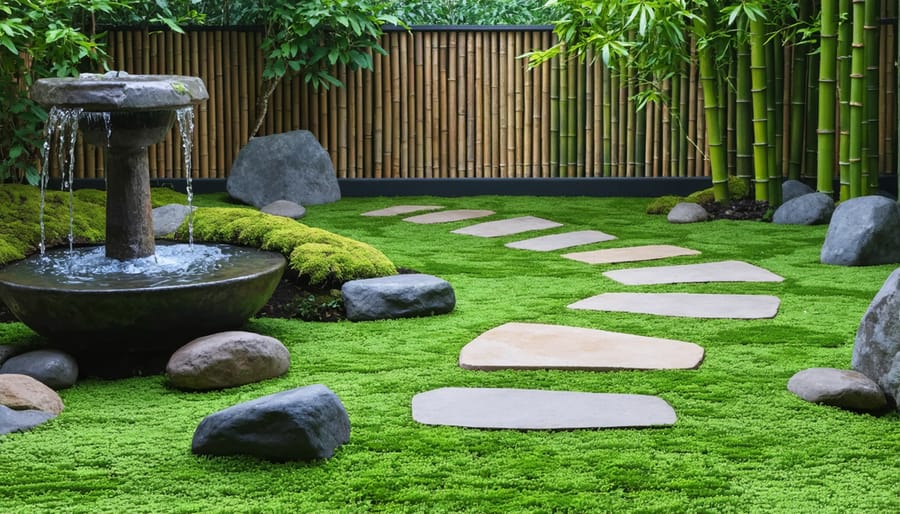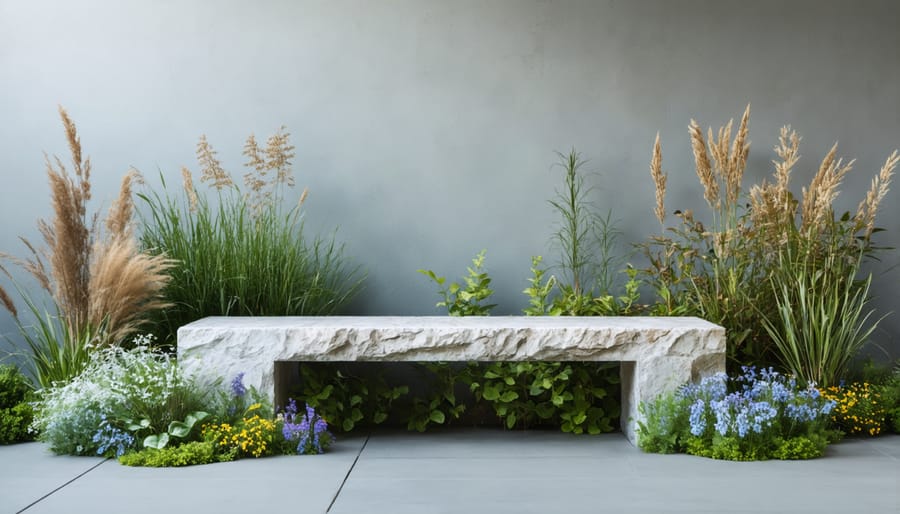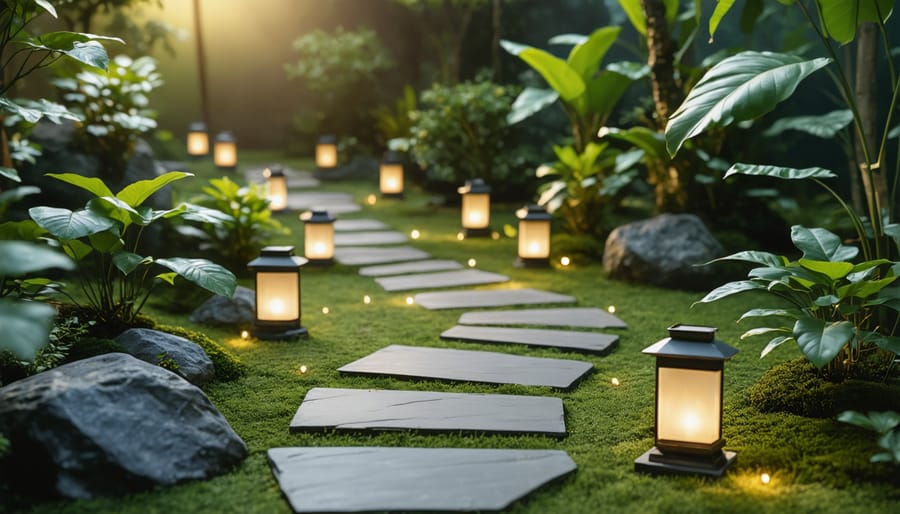Transform your outdoor space into a serene sanctuary by placing natural stone pathways that meander through native plants, creating an intuitive flow that guides both movement and meditation. Install a minimalist water feature – even a simple bamboo fountain – to introduce the calming sound of flowing water while attracting local wildlife. Position comfortable, weather-resistant seating in strategic locations that capture both shade and natural views, turning your yard into an eco-friendly entertainment paradise. Layer your zen garden with drought-resistant grasses and moss to create texture without excessive maintenance, incorporating smooth river rocks and sustainable bamboo screens for privacy and visual harmony.
Ground your design with mindful lighting choices – solar-powered lanterns and LED path lights that cast soft, warm glows after sunset while minimizing energy consumption. Select materials and plants that reflect your local climate, reducing both maintenance needs and environmental impact while maximizing your space’s natural potential for tranquility.
Essential Elements of a Zen Outdoor Space
Natural Materials and Sustainable Choices
Creating a zen outdoor space naturally aligns with eco-conscious design, making sustainable material choices both practical and aesthetically pleasing. Natural materials like bamboo, reclaimed wood, and locally sourced stone not only reduce environmental impact but also bring authentic character to your space.
Consider incorporating sustainably harvested bamboo for screens, fencing, or decorative elements. This fast-growing material is both renewable and brings an authentic Asian aesthetic to your zen garden. For pathways and seating areas, opt for permeable materials like gravel or recycled pavers that allow rainwater to naturally filter into the ground.
Reclaimed wood makes excellent material for benches, deck areas, or decorative features. Each piece tells a story through its weathered appearance, adding depth and character to your outdoor sanctuary. For ground cover, choose native plants and moss varieties that require minimal maintenance and water, naturally adapting to your local climate.
Stone elements can be sourced from local quarries, reducing transportation emissions while supporting regional businesses. Consider using river rocks for meditation gardens or natural boulder seating arrangements. For lighting, solar-powered fixtures provide gentle illumination without increasing energy consumption.
When selecting furniture and accessories, look for pieces made from sustainable materials like FSC-certified wood or recycled metals. These choices not only support environmental conservation but also create a more authentic connection to nature, enhancing the peaceful atmosphere of your zen space.
Water Features and Energy Efficiency
Water features are essential elements in creating a serene zen outdoor space, and when designed thoughtfully, they can be both beautiful and environmentally conscious. The gentle sound of flowing water not only masks unwanted noise but also creates a natural meditation aid that helps reduce stress and anxiety.
Consider incorporating a solar-powered fountain as your centerpiece. These sustainable features require no electrical hookup and operate freely using the sun’s energy. For maximum efficiency, position your fountain where it receives optimal sunlight during peak hours. Small recirculating waterfalls and bamboo water spouts are excellent low-energy alternatives that use minimal electricity while providing the same peaceful ambiance.
To reduce water waste, install a closed-loop system that continuously recycles water. Adding aquatic plants like water lilies or lotus not only enhances the visual appeal but also helps maintain water quality naturally, reducing the need for chemical treatments. Consider collecting rainwater in decorative rain chains or barrels to supply your water features, making them completely self-sustainable.
For those in drought-prone areas, consider a dry creek bed design with strategically placed rocks and pebbles. This zen-inspired feature creates the illusion of flowing water without actually using any, while still providing visual interest and maintaining the peaceful atmosphere of your outdoor sanctuary.
Remember to regularly maintain your water features by cleaning filters and checking water levels to ensure they operate at peak efficiency while conserving resources.

Creating Balance Through Mindful Design
Plant Selection and Low-Maintenance Landscapes
Creating a low-maintenance zen garden starts with smart plant selection, focusing on native species that naturally thrive in your local climate. These plants require less water, fertilizer, and overall care while supporting local wildlife and maintaining ecological balance.
Consider incorporating drought-resistant plants like ornamental grasses, which add movement and texture to your space. Japanese Forest Grass and Blue Fescue are excellent choices that capture the essence of zen gardens while requiring minimal upkeep. Succulents and sedums also work wonderfully, creating interesting focal points without demanding constant attention.
For year-round interest, mix evergreen shrubs like Japanese Holly or Boxwood with seasonal bloomers such as Japanese Anemone or Autumn Joy Sedum. These combinations provide structure and visual appeal throughout the changing seasons while maintaining the peaceful atmosphere essential to zen spaces.
Layer your plantings with ground covers like Creeping Thyme or Moss, which naturally suppress weeds and reduce maintenance needs. These living carpets create a seamless transition between hardscape elements and larger plants, contributing to the garden’s unified appearance.
To minimize maintenance further, group plants with similar water needs together and implement efficient irrigation systems. Adding a layer of natural mulch helps retain moisture, suppress weeds, and gradually improve soil quality as it breaks down.
Remember to leave adequate space between plants, considering their mature size. This thoughtful spacing not only reduces competition for resources but also creates the clean, uncluttered look characteristic of zen gardens. Plus, it makes routine maintenance tasks like pruning and weeding much more manageable.
Minimalist Furniture and Sustainable Seating
Creating a zen outdoor space starts with choosing the right sustainable outdoor furniture that embodies both minimalist design and eco-conscious materials. Look for pieces crafted from reclaimed teak, bamboo, or FSC-certified wood, which offer durability while maintaining a natural, organic feel. These materials age beautifully and require minimal maintenance, perfectly aligning with zen principles of simplicity and harmony.
Consider low-profile seating options like floor cushions made from weather-resistant, recycled materials or simple wooden benches with clean lines. These choices not only create a serene atmosphere but also reduce visual clutter in your outdoor sanctuary. Platform seating areas built from sustainable composite materials can serve as both functional furniture and architectural elements, seamlessly blending with your garden’s landscape.
For versatile seating arrangements, opt for modular pieces that can be easily rearranged to accommodate different activities or group sizes. Look for furniture that incorporates natural finishes and earth tones to maintain connection with nature. Avoid synthetic materials when possible, and choose pieces treated with non-toxic, eco-friendly finishes.
Storage solutions should follow the same minimalist principles – consider hollow bench seating or simple storage boxes made from sustainable materials to keep cushions and accessories organized and protected. Remember, less is more in zen design, so select pieces that serve multiple purposes while maintaining clean lines and uncluttered spaces.
To extend furniture life and reduce waste, invest in quality covers made from recycled materials and implement proper care routines. This approach not only protects your investment but also supports sustainable living practices while maintaining the peaceful atmosphere of your outdoor retreat.

Sustainable Lighting Solutions
Solar-Powered Ambiance
Illuminate your zen outdoor space sustainably with solar-powered garden lighting that creates the perfect ambiance while respecting the environment. Strategic placement of solar lanterns along pathways and meditation areas ensures safe navigation while maintaining the peaceful atmosphere after sunset. Consider placing string lights in trees or along pergolas to create a gentle canopy of light that mimics starlight.
For maximum efficiency, position solar panels where they receive direct sunlight during peak hours. Combine different lighting styles – try placing stake lights near plants, hanging lanterns from branches, and using tabletop solar votives for intimate seating areas. Opt for warm white LEDs rather than bright white to maintain the calming atmosphere essential to a zen space.
Remember to space your lights thoughtfully – less is often more when creating a serene environment. Focus on highlighting key features like water features or Buddha statues, and create subtle pools of light rather than flooding the entire area with brightness. This measured approach to lighting helps maintain the meditative quality of your outdoor sanctuary while ensuring functionality.

Natural Light Management
Natural light plays a vital role in creating a serene zen outdoor space, and thoughtful light management can transform your area throughout the day. Start by observing how sunlight moves across your space during different times – this will help you plan your layout more effectively.
Consider incorporating reflective elements like mirrors, light-colored stones, or metallic wind chimes to bounce light into shadier areas. These not only brighten dark corners but also create mesmerizing light patterns that enhance the meditative atmosphere.
Strategic placement of plants can help you control light and shadow. Tall bamboo or ornamental grasses can create gentle, moving shadows that add depth and tranquility to your space. For areas that receive intense sunlight, consider installing pergolas or shade sails that filter light rather than block it completely.
Light-colored materials like white gravel or pale stone pavers can help brighten your space naturally, while darker elements can be used to create grounding contrast. Remember that natural light changes seasonally, so design your space with year-round functionality in mind.
Maintenance and Long-Term Sustainability
Maintaining a zen outdoor space isn’t just about keeping it tidy – it’s about nurturing a sustainable sanctuary that thrives with minimal environmental impact. By incorporating smart outdoor living ideas and eco-friendly practices, you can ensure your peaceful retreat remains beautiful for years to come.
Start by choosing native plants that naturally thrive in your climate. These plants require less water and maintenance while supporting local wildlife. Implement a smart watering system with drip irrigation or soaker hoses to minimize water waste. Consider installing a rain barrel to collect rainwater for your garden – it’s both sustainable and cost-effective.
Regular maintenance doesn’t have to be time-consuming. Set aside 15-20 minutes each week for basic tasks like removing fallen leaves, trimming dead branches, and checking water features. This prevents bigger issues from developing and maintains the space’s peaceful atmosphere. For gravel or stone pathways, simply rake them monthly to maintain their clean lines and prevent weed growth.
To keep your zen space eco-friendly, avoid chemical pesticides and fertilizers. Instead, use organic composting methods and natural pest deterrents like companion planting. Cedar mulch not only helps retain moisture and suppress weeds but also naturally repels insects while adding to the space’s earthy aesthetic.
For hardscape elements like wooden decks or bamboo screens, apply natural sealants annually to protect them from weather damage. Choose sustainable materials when replacing or adding elements – reclaimed wood, recycled metal, or locally sourced stone are excellent options that age beautifully and reduce environmental impact.
Consider creating a maintenance calendar that aligns with seasonal changes. Spring calls for pruning and fresh mulching, summer focuses on water management, fall requires leaf cleanup, and winter is perfect for structural repairs and planning upcoming improvements. This systematic approach helps maintain the space’s tranquility while preventing overwhelming maintenance tasks.
Remember that a zen space should evolve naturally over time. Allow certain areas to develop their own character while keeping the core elements well-maintained. This balance between control and natural growth creates a truly sustainable outdoor sanctuary that brings peace for years to come.
Creating a zen outdoor space is more than just arranging furniture and adding a few plants – it’s about crafting a personal sanctuary that brings peace, balance, and harmony to your daily life. Throughout this guide, we’ve explored the essential elements that transform an ordinary outdoor area into a tranquil retreat, from selecting the right natural materials to incorporating mindful water features and creating purposeful spaces for meditation and relaxation.
Remember that your zen garden doesn’t need to be perfect from day one. Start with the basics – declutter your space, choose a few key elements that speak to you, and build from there. Whether you have a sprawling backyard or a modest balcony, the principles of zen design can be adapted to any space and budget.
Consider beginning with simple steps like adding bamboo screens for privacy, introducing a small water fountain for soothing sounds, or creating a dedicated meditation corner with comfortable seating. As you spend time in your space, you’ll naturally discover what elements bring you the most peace and can expand upon those aspects.
The journey to creating your zen outdoor space is personal and ongoing. Let your space evolve with you, and don’t be afraid to make adjustments as you discover what works best for your lifestyle. The most important thing is that your outdoor sanctuary becomes a place where you can disconnect from the chaos of daily life and reconnect with yourself and nature.
Take the first step today – your perfect zen outdoor space awaits.
